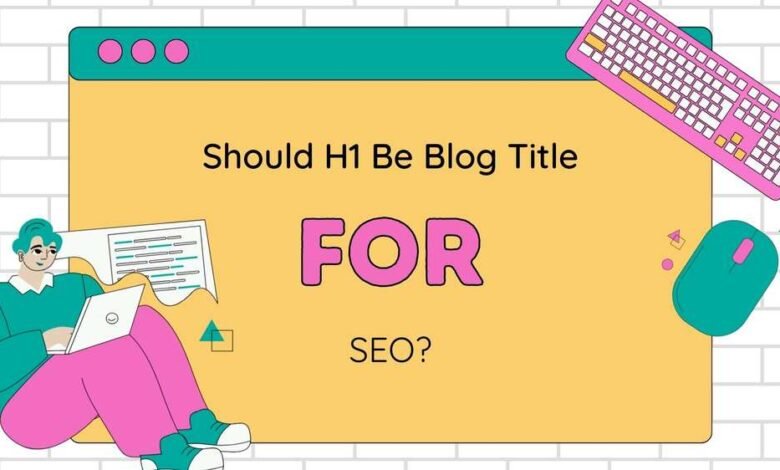Should H1 Be Blog Title for SEO? Exploring the Impact on Rankings

Should H1 Be Blog Title for SEO: When creating a blog post, you might wonder, “Should H1 be blog title for SEO success?” This is a common question among bloggers and website owners trying to boost their site’s rankings. The H1 tag is usually the largest heading on a page, and many believe it has an essential role in SEO. But does setting your H1 as the blog title actually improve SEO?
In this post, we’ll explore why the H1 tag is so important and whether it should match the blog title. Understanding the best ways to use H1 can help your content perform better on search engines and provide a better experience for readers. Let’s look deeper into the benefits, best practices, and key things to keep in mind to optimize your H1 for SEO.
What is an H1 Tag, and Why Does It Matter for SEO?
The H1 tag is one of the main headings on a web page and is usually used to introduce the main topic. When users visit a page, the H1 helps them quickly understand what the page is about. But why does it matter for SEO? The H1 tag also gives search engines clues about your page’s main focus, which helps it show up in search results.
Choosing a relevant and clear H1 tag can make your page easier to understand, which may lead to higher rankings. The H1 tag is a key part of on-page SEO, as it helps search engines and visitors see what information the page provides. If the H1 tag is well-chosen, it can attract more readers and increase your site’s engagement.
For many bloggers, the question is, “Should H1 be blog title for SEO success?” Since H1 tags play such a big role, it makes sense to want the best format possible. Deciding whether to make your blog title the H1 tag depends on several factors, which we’ll explore in this guide.
Should H1 Be Blog Title for SEO? Pros and Cons Explained
When thinking about whether your H1 should match your blog title, it’s helpful to weigh the pros and cons. Using the blog title as the H1 can make it simple and save time. For readers, seeing a familiar blog title at the top can make your content feel clear and aligned.
However, there are also downsides. If the H1 is too similar to other headings or doesn’t add new value, it could make the page feel repetitive. Also, search engines may prefer unique H1 tags that tell them more about the page content. In cases where the title and H1 are too similar, the page might not rank as well for certain keywords.
In many situations, choosing an H1 that is slightly different from the blog title might work best. This way, you can capture extra keywords or phrases in your H1 that aren’t in the blog title. For example, adding extra words to the H1 can help with SEO and make the page more engaging for readers.
Best Practices for Using H1 Tags on Your Blog
For bloggers, understanding how to use H1 tags well is important for creating content that stands out. Here are some best practices to consider when setting up H1 tags:
- Keep it Short and Relevant: Make sure the H1 tag is easy to understand at a glance.
- Use Descriptive Language: Use words that directly describe what your post is about.
- Avoid Keyword Stuffing: Use keywords naturally in the H1 without overloading it.
The key is to focus on both search engines and users. When your H1 is clear and informative, readers will feel engaged, and search engines can better match your content to relevant searches. Additionally, think about the H1 as a way to set the tone of your post—it should give readers a good reason to keep reading.
Finally, ensure that each H1 tag is unique across all your pages. This helps avoid confusion and makes it easier for search engines to rank your pages separately.
Should H1 Be Blog Title for SEO or Unique? Choosing the Right Approach
Deciding if the H1 should match the blog title for SEO depends on your content and goals. In some cases, using the blog title as the H1 makes sense if it’s short and descriptive. In other cases, creating a unique H1 may provide better SEO benefits. Let’s dive into when each approach works best.
- When to Use the Blog Title as H1: If your title is already optimized, like a clear and short question or statement.
- When to Create a Unique H1: If adding more keywords in the H1 could help, or if you want a different phrasing for search intent.
The key is to consider both user experience and SEO. Sometimes, making the H1 different from the blog title can help cover more search terms, which may drive extra traffic to your page. Testing different H1 approaches may be helpful to see which works best for your site’s performance.
Common Mistakes with H1 Tags and How to Avoid Them
Setting up H1 tags can be straightforward, but some mistakes can affect your SEO. Here are a few common errors and ways to avoid them:
- Repetitive H1 and Titles: Using the same H1 across multiple pages can confuse search engines.
- Overloaded Keywords: Using too many keywords in the H1 can look unnatural and may lower rankings.
- Too Long or Short: Very short H1 tags may lack detail, while overly long ones can be confusing.
By avoiding these mistakes, you can create H1 tags that make a stronger impact. Keep in mind that small tweaks to your H1 can help both your readers and your SEO.
Expert Insights: Should H1 Be Blog Title for SEO? (With Subheadings)
For this heading, insights from SEO experts can provide valuable guidance on the question, “Should H1 be blog title for SEO?” Let’s break it down into tips that experts suggest.
When to Match Blog Title with H1
- Simple Blog Topics: Short and catchy titles work well as H1.
- Clear Intent Titles: H1 matching the blog title can make the topic clear to readers and search engines.
When to Make H1 Different from Blog Title
- Broader Keywords Needed: Sometimes, an adjusted H1 covers extra keywords.
- Longer Titles for SEO: Adding detail to the H1 can help for SEO without changing the main message.
Taking advice from experts can simplify the decision, ensuring your H1 tag aligns with both user and SEO goals. These strategies help keep the reader engaged and improve your page’s performance in search rankings.
Conclusion
In conclusion, figuring out whether “should H1 be blog title for SEO” is a big question for many bloggers. Choosing the right H1 tag can really help your content reach more readers. If your H1 matches the blog title, it can be clear and straightforward. But sometimes, having a different H1 can help attract more visitors by covering extra keywords.
It’s all about finding what works best for your blog. Always remember to keep your H1 clear and easy to read. By following the tips in this post, you can make sure your H1 tags help improve your SEO and make your blog more enjoyable for readers. Happy blogging!
FAQs
Q: What is an H1 tag?
A: An H1 tag is the main heading of a webpage that tells visitors what the page is about.
Q: Should my blog title be the same as my H1?
A: It can be, but it’s not always necessary. Sometimes, a different H1 can help with SEO.
Q: How many H1 tags can I use on one page?
A: You should only use one H1 tag per page to keep things clear for search engines.
Q: Does H1 really affect SEO?
A: Yes, a good H1 tag can help your page rank better in search results.




